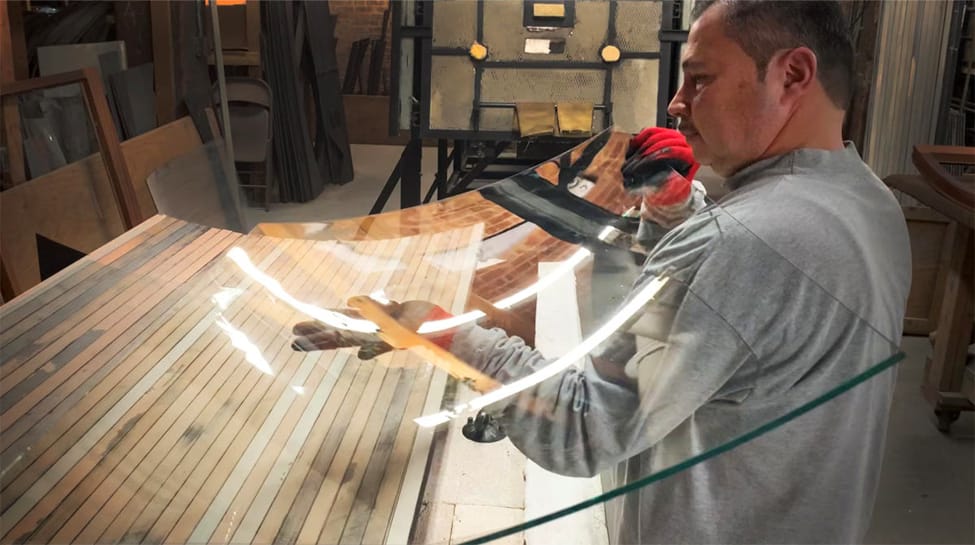Last Updated on March 27, 2025 by SampleBoard
In recent years, homeowners have increasingly turned to glass as a stylish and functional material to upgrade their living spaces.
As we outlined in A Comprehensive Guide To Different Types Of Windows, windows are an important part of any home as they add aesthetic appeal, energy efficiency, and functionality to your living space.
Glass has the unique ability to create a sense of openness, enhance natural light, and offer sleek, modern aesthetics.
Among the various glass applications, curved glass has emerged as a standout feature.
As such, a report from Research Corridor showed how the global curved glass panel market is projected to experience a strong CAGR of over 6% from 2024 to 2030.
This is because curved glass panels are increasingly incorporated into modern building designs, valued for their ability to create sleek, seamless, luxurious, and futuristic structures.
From windows and doors to partitions and staircases, curved glass revolutionizes interior and exterior design.



Making curved glass is slightly different from regular flat glass.
To explain the process, the artisans at Flickinger Glassworks provide a detailed guide on creating curved glass.
Curved glass, also known as bent glass, is produced by heating glass to a specific temperature until it becomes pliable.
The glass is then molded into a desired shape and slowly cooled to retain its curvature.
The result is a glass panel with smooth, rounded lines that can seamlessly blend into various architectural styles.
The production of curved glass involves several steps:



Curved glass windows are perhaps the most common use in residential spaces.
They offer a panoramic view, allowing more natural light to flood the home while adding a unique architectural touch.
Homes in scenic locations particularly benefit from curved windows as they provide unobstructed views of the surrounding landscape.
A recent example was shown on Dezeen. Architectural studio CAN extended a terraced London house with a large curved window to redraw its connection to the garden.
The home’s centerpiece references a Victorian shop front.
Modern entryways often incorporate curved glass doors to create a grand and welcoming entrance.
Sliding or revolving glass doors with a gentle curve can enhance the flow between indoor and outdoor spaces, making them ideal for patios and garden entrances.
Curved glass partitions can elegantly separate different areas within a home without sacrificing openness.
They work well in open-plan layouts, allowing light to pass through while offering a subtle division between spaces like the kitchen and living room.
Glass staircases and balustrades with curved glass panels add a touch of sophistication to multi-level homes.
They provide safety without obstructing the view, creating a light and airy atmosphere.
Curved glass shower enclosures are a luxurious addition to modern bathrooms.
Their sleek design maximizes space while offering a spa-like experience.
They are particularly useful in smaller bathrooms, as the curved shape creates the illusion of more space.
Curved glass skylights can introduce natural light into attics or dark corners of a home.
Their unique shape allows light to disperse more evenly, brightening up interiors while adding an architectural focal point.


Curved glass introduces smooth, flowing lines that soften harsh architectural edges.
It creates a modern and sophisticated look that can complement both contemporary and traditional homes.
The curvature of the glass captures and disperses light more effectively than flat glass, resulting in brighter interiors.
This reduces the need for artificial lighting and creates a warm, inviting atmosphere.
A UCLA study found that natural light has a powerful and often positive effect not only on mental health but also on physical health and general well-being.
Curved glass windows and doors offer wider viewing angles compared to flat glass.
Homeowners can enjoy expansive, uninterrupted views, especially in properties with scenic surroundings.
High-performance curved glass can be produced with double or triple glazing to improve insulation.
Low-emissivity coatings can further enhance thermal efficiency, reducing heating and cooling costs.
Curved glass is often tempered or laminated, making it more durable and resistant to impact.
It can withstand harsh weather conditions, making it suitable for exterior applications.
Curved glass can be custom-made to fit unique spaces, enabling homeowners to optimize their floor plans.
This is particularly useful in small spaces where every inch counts.


When considering curved glass for your home, it is essential to work with experienced suppliers and installers.
Custom curved glass is a specialized product, and precise measurements are crucial for a perfect fit.
Consulting with an architect or interior designer can help ensure that the glass integrates seamlessly into your home's overall design.
Key Factors to Consider:



Curved glass is more than just an aesthetic feature; it is a versatile and functional element that can transform a home.
Whether used in windows, doors, partitions, or staircases, curved glass offers a unique blend of elegance, light, and efficiency.
With its ability to maximize space, enhance natural light, and provide structural strength, curved glass is a worthwhile investment for homeowners seeking to elevate their living spaces.
As glass technology continues to evolve, the possibilities for incorporating curved glass into residential design are only set to expand, making it a trend that is here to stay.
For more on the latest home, interior & wedding ideas, do read our Home Trends for 2025.